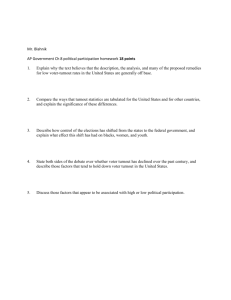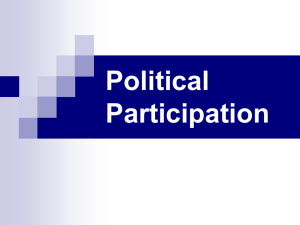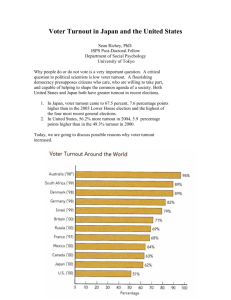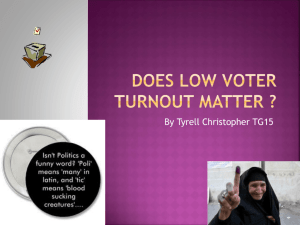AP US GOVERNMENT & POLITICS REVIEW
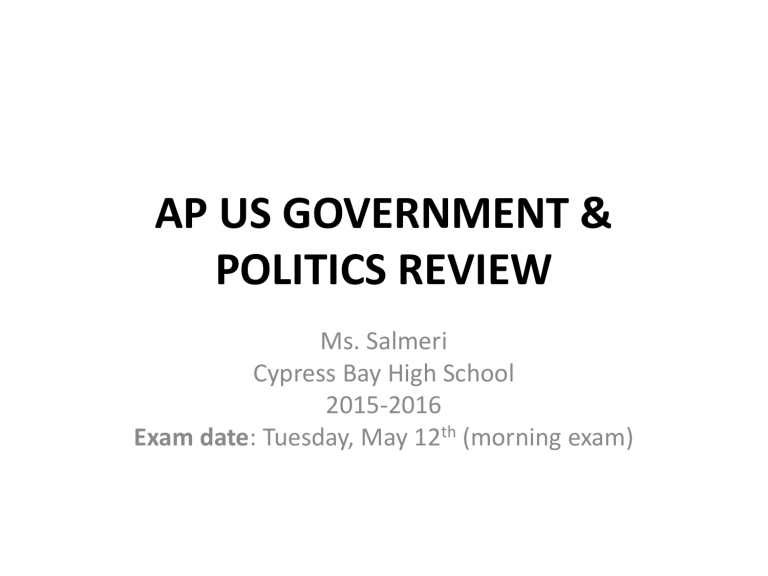
AP US GOVERNMENT &
POLITICS REVIEW
Ms. Salmeri
Cypress Bay High School
2015-2016
Exam date: Tuesday, May 12 th (morning exam)
THE COURSE
• AP Government & Politics is mostly conceptual
– Concepts of government by applying political situations
– The course is broken into 6 units consisting of a multitude of topics to help you better master these concepts
• I. Constitutional Underpinnings (5–15%)
• II. Political Beliefs & Behaviors (10–20%)
• III. Political Parties, Elections, Interest Groups & Mass Media
(10–20%)
• IV. Institutions of Government (35–45%)
• V. Public Policy (5–15%)
• VII. Civil Rights & Civil Liberties (5–15%)
• *Percentages equal roughly material covered on the AP exam.
THE EXAM
• Multiple choice – 50% (60 POINTS)
– 60 questions
– 45 minutes
– NO PENALTY FOR WRONG ANSWER
• Free Response – 50% (60 POINTS)
– 4 questions (15 points each)
– 100 minutes
– MUST answer ALL of them
STATS
SCORING (AVERAGE)
MASTERING THE MULTIPLE
CHOICE
TIME AND GRADE
• You have 45 minutes for this section
• 50% of overall grade
• Allow less than one minute for each question
• Answer the ones you know for sure first, skip what you don ’ t know and come back
• Read the question, THINK about the answer, then find the answer from options
– This is so you don’t trick yourself out of the correct answer with the distractors
• ANSWER EVERY QUESTION! You can only EARN points!
QUESTIONS
• Definition/identification, analytical, conceptual
• There’s no cheating the exam – you just have to know your stuff :/
• Know your VOCAB!!! – most questions are testing retention of vocab
• Use knowledge of US History/Human
Geo/Economics/Political culture to infer what you don’t know
• ANSWER EVERY QUESTION!!!
MC EXAMPLE
• DEFINITION:
• Which of the following best describes GERRYMANDERING?
a. The party in power wins four or five surrounding districts by very small margins b. The Supreme Court requires that state legislatures must adopt the doctrine of one person, one vote c.
The party in control of the state legislature draws district boundaries in such a way as to favor its own candidates in subsequent elections d. By polling voters, party officials are able to determine how citizens will vote e. The public decides which issues are most important and tells the elected officials how to vote on specific bills
ANSWER
• DEFINITION:
• Which of the following best describes GERRYMANDERING?
a. The party in power wins four or five surrounding districts by very small margins b. The Supreme Court requires that state legislatures must adopt the doctrine of one person, one vote c.
The party in control of the state legislature draws district boundaries in such a way as to favor its own candidates in subsequent elections d. By polling voters, party officials are able to determine how citizens will vote e. The public decides which issues are most important and tells the elected officials how to vote on specific bills
• APPLICATION:
MC EXAMPLE
• When a child ’ s parents both identify strongly with the same political party, the child will most likely
– A. Identify with the opposing party
– B. Identify with the parents ’ party
– C. Have a low sense of political efficacy
– D. Become an independent rather than a party identifier
– E. Become alienated from the political system
ANSWER
• APPLICATION:
• When a child ’ s parents both identify strongly with the same political party, the child will most likely
– A. Identify with the opposing party
– B. Identify with the parents ’ party
– C. Have a low sense of political efficacy
– D. Become an independent rather than a party identifier
– E. Become alienated from the political system
MC EXAMPLE
• CONCEPTUAL:
• The development of the two party system in the
United States is best accounted for by
– A. The Twelfth Amendment
– B. Proportional representation
– C. Multimember legislative districts
– D. Single-member legislative districts
– E. Strong party loyalty of elected representatives
ANSWER
• CONCEPTUAL:
• The development of the two party system in the
United States is best accounted for by
– A. The Twelfth Amendment
– B. Proportional representation
– C. Multimember legislative districts
– D. Single-member legislative districts
– E. Strong party loyalty of elected representatives
WRITING FRQ ’ S
FRQ BASICS
• 4 MANDATORY FRQ ’ s – ANSWER ALL OF THEM
– You can only EARN points
• Questions are broken down into parts (Part A, B, C, etc.)
– LABEL YOUR PARTS!!!
– i.e. – 1a) , 2b) , 3c)
• If you don ’ t label, the reader doesn‘t ALWAYS know what you ’ re answering.
• If you feel you answered 3c in 3b then REPEAT YOURSELF!
– YOU CAN ONLY EARN POINTS SO WRITE, WRITE,
WRITE!!!
• Don ’ t contradict yourself.
TIME AND GRADE
• You have 100 minutes for this section
• Take the time to UNDERSTAND THE QUESTION
• 50% of overall grade
• Allow 25 minutes for each question
• Spend 5 minutes reading and jotting down a few words on each point you want to cover
– HINT: the question itself gives you context clues on how they want you to answer it. Examine that.
• Then, spend 15 minutes writing your response
• Save the last 5 minutes to review your response
FRQ VERBS
• List/Identify - Listing or identifying is a task that requires no more
than a simple enumeration of some factors or characteristics. A list does not require any causal explanations.
– For example, a student might be asked to list or identify three characteristics presidents consider when making appointments.
Such a list, which could be bulleted or numbered, might include party, race, gender, etc.
• Define - A definition requires a student to provide a meaning for a word or concept.
– Examples may help to demonstrate understanding of the definition. First define, then give example (not always necessary but may help augment your response). Students may be instructed to note the term’s significance as part of the definition.
FRQ VERBS
• Describe - A description involves providing a depiction or
portrayal of a phenomenon or its most significant characteristics. Descriptions most often address “what” questions.
– For example, if students are asked to describe reasons for the decline in voter turnout, they must do more than simply list facts—they must actually describe the reasons. Students may explain that the expansion of suffrage led to a decline in overall voter turnout because once voting was made available to more individuals, the overall percentage of those voting declined.
Students need to focus on the details of a process and/or a concept.
FRQ VERBS
• Explain - An explanation involves the exploration of possible causal relationships. When providing explanations, students should identify and discuss logical connections or
causal patterns that exist between or among various political phenomena. Typically this requires students to show a result. (Use terms like “as a result” or “therefore”)
– For example if a student were asked to explain how the first amendment addressed Anti-Federalist concerns they would need to first give context by describing the first amendment and the beliefs of the Anti-Federalists and then connect them. Anti-Federalists were concerned with a tyrannical central government with the ability to deprive Americans of civil liberties therefore including a provision in the Bill of Rights allowing Americans to speak out against the government or petition the government without fear of consequence eased their overall concern.
FORMAT EXAMPLES
• Define Federalism. (1 POINT)
• Identify two characteristics of an accurate public opinion poll. (2 POINTS)
• Describe the winner-take-all feature of the
Electoral College (1 POINT)
• Explain how one of the following has increased the power of the federal government relative to the power of state governments (1 POINT each)
• Americans with Disabilities Act
• Civil Rights Act of 1964
• Sometimes combined:
– Identify and explain two reasons why voter turnout has been higher in presidential elections than in midterm elections. (4 POINTS)
BREAKING DOWN THE QUESTION
• 1. Understand the pretext:
• Voter turnout is the amount of the electorate that vote, so if this question is about turnout it must be about whether people show up to vote or don’t show up to vote – it increases sometimes, decreases sometimes (why?) because of provisions in the Constitution, national laws, and/or, demographic changes
PART A
•
Identify (just list) pick from 1 of 3 amendments and how it effect (raised or lowered)
•
You can also answer ALL 3 if you want!!!
•
15
th
, 19
th
, 26
th
ALL increased/raised the potential for turnout
PART B
• Explain how 2 laws affect (raised or lowered) turnout. Explain questions REQUIRE context to be established as well as some sort of result
• So…
• Motor Voter Laws –
– First define
– Second EXPLAIN how this would affect voter turnout
• Photo identification Laws –
– First define
– Second EXPLAIN how this would affect voter turnout
PART C
• Describe how a demographic feature could (most likely) affect if someone would vote
• Education
– You have to be aware of statistics supported those with
• Lower educated individuals don’t vote much as those with higher education
• Age
– You have to be aware of statistics supporting those that are
• Younger don’t voter as much as elderly
PART D
• Explain why voter turnout is different
• Again, context , describe the difference between the 2 elections and THEN explain WHY that difference accounts for difference in turnout.
– Most students make the mistake by not providing context and therefore cannot complete the answer.
• A presidential election is an election for the President of the
US versus a midterm election which is just for member so
Congress (HOR and Senate ). The electorate typically views the presidency as a more important office, as opposed to members of Congress, and therefore turnout at a higher rate to vote for the president than members of Congress .
FRQ: DO ’ S AND DON ’ TS
Do ’ s
• Use PEN
• Read & answer what the question wants
– List
– Define
– Explain
– Describe
• LABEL!
• Cross out for mistakes
• Answer questions directly asked – link answer to ?
• Answer what you know
– You can only EARN points
• Be SPECIFIC
• KISS
Dont ’ s
• Use PENCIL
• Write a thesis
• Write sloppy
• Write in cursive
• Write a conclusion
• Leave out vital information
• Give your opinion – no one cares!
• Rant without getting to the point
CONTENT REVIEW
Some basics – this is NOT everything, but it’s helpful
I. CONSTITUTION
• Articles of Confederation
– First attempt, weak central gov., NO TAXING!
– Shays ’ Rebellion
• Structure: Articles (7) ; Amendments (27)
– I, II, III
• Branches
– IV
• Full Faith and Credit, Privileges and Immunities, Extradition
– V – Amendment process
• 2/3 Congress; ¾ states
– VI – Supremacy Clause
I. CONSTITUTION
• The Federalist Papers
– Collection of essays urging ratification of Constitution
– James Madison, Alexander Hamilton, John Jay
• #10
– American republic manages factions
• #51
– “ Ambition made to counteract ambition ” – checks and balances/separation of powers
• #78
– Judiciary weak
I. Constitution
• Article I – Legislative Branch
• House v. Senate
• Requirements
• Powers
– Expressed v. implied
• Necessary and proper; commerce clause
• Expanded by:
– McCulloch v. Maryland
– Gibbons v. Ogden
I. Constitution
• Article II – Executive Branch
• Requirements
• Powers
• Electoral College
I. Constitution
• Article III – Judiciary
• NO judicial review UNTIL…
– Marbury v. Madison (1803)
I. Constitution
• Madisonian principles
• Popular Sovereignty – power to govern belongs to the people, gov ’ t based on the consent of governed
• Separation of Powers – division of gov ’ t between branches: executive, legislative and judicial
• Checks and Balances – a system where branches have some authority over others
• Limited Government – gov ’ t is not all-powerful, and it does only what citizens allow
• Federalism – division of power between central government and individual states
I. AMENDMENTS
• 1-10 = Bill of Rights
– Guarantee people protection from abuses of
FEDERAL government
• 11-27 added as needed: procedural, civil rights
AMENDMENT MNEMONICS
• BILL OF RIGHTS
• 1: RAPPOS
• 2: thumb and index finder make a gun; 2 arms
• 4: “ What are you searching 4 ” ?
• 5: “ I plead the 5 th ”
• 6: Speedy 6
• 8: look like handcuffs
• 9: #9 makes more rights mine!
• 10: state right (10 letters)
AMENDMENT MNEMONICS
• PROCEDURAL:
–
12, 20, 22, 23, 25, 27
• CIVIL RIGHTS/PROGRESSIVE:
–
(13, 14, 15) RECONSTRUCTION
(16, 17, 18, 19) PROGRESSIVE, 24,
26
AMENDMENT MNEMONICS
• 12: #1 and #2 positions
• 20: Jan. 20 inauguration
• 22: 2 terms
• 23: 3 votes for DC
• 25: 25 if he ’ s not alive
• 27: highest one, pay increases
AMENDMENT MNEMONICS
• 13: FREE
• 14: CITIZENS
• 15:VOTE
• 16 -19: In come Senators with Wine and
Women
• 24: polling open 24 hours
• 26: 26 – (2 + 6) = 18 – 18 to vote
VI. CIVIL RIGHTS & LIBERTIES
• Derived from 14 th Amendment equal protection clause
• Incorporation Doctrine
• Selective incorporation
• Civil Rights – government took away arbitrarily
– Suffrage, education, equality in workplace
• Civil Liberties – guaranteed rights against government abuse of power
– Speech, religion, criminal rights
VI. COURT CASES
• 1 st Amendment
– Religion (Establishment Clause and Free Exercise Clause)
• Engel v. Vitale, Lemon v. Kurtzman,
– Speech (Symbolic, press, spoken/written)
• Tinker v. Des Moines, Texas v. Johnson, Schenck v. US,
• 4 th Amendment
– Search and seizure
• Mapp v. Ohio
• 5th Amendment
– Criminal rights
• Miranda v. Arizona, Gideon v. Wainwright
VI. COURT CASES
• 6 th Amendment
– Fair and speedy trial
• 8 Th Amendment
– Cruel and unusual punishment
• Furman v. Georgia, Gregg v. Georgia
• 9 th Amendment
– Privacy
• Roe v. Wade, Griswald v. Connecticut
VI. CIVIL RIGHTS
• Civil Rights Act of 1964
• Voting Rights Act of 1965
• Equal Rights Amendment (never passed)
• American ’ s with Disabilities Act
• Lawrence v. Texas
– Dismantled state sodomy laws
• Brown v. Board of Education
– Desegregated schools
• University of California v. Bakke
– Affirmative action
I. FEDERALISM
• System of government where power is divided between a central structure (national government) and smaller units (states, local gov)
– Contrast unitary, confederation
• Divides power, decentralizes power, conflicts b/t nat ’ l gov and states
• Delegated, reserved, concurrent
• Dual, Cooperative, Fiscal (grants), New (divert back to states)
II. SOCIALIZATION
• Political ideology
• Primary factors: family (parents), education, geographic region, religion, gender, social class, race, ethnicity
• Liberal, conservative, moderate
• Turnout/mobilization
– Political efficacy
– Grassroots mobilization
– Motor Voter Act
II. POLITICAL OPINION
• Polls – gauge public interest
• Random sample, representative, low margin of error, neutral questions
III. POLITICAL PARTIES
• First Party System: Federalists v. Anti
• Not IN the Constitution
• GOAL: control government through the winning of elections
• Democratic Party (1820 ’ s)
– Democratic National Committee
• Republican Party (1860 ’ s)
– Republican National Committee
• Current platforms
• National, state and local – somewhat independent of each other
• Third Parties
• Realignment v. Dealignment
III. ELECTIONS
• Reapportionment
• Redistricting
• Gerrymandering
• Congressional: midterm, congressional, off-year
• Presidential: general
• Narrowing down:
– primary OR caucus
• Open or closed
• New Hampshire and Iowa
• Conventions
– Superdelegates
• Campaign finance
– PAC ’ s, FECA (FEC), soft money, hard money, SuperPac ’ s, Buckley v. Valeo, Citizen ’ s
United, McCain Feingold
IV. CONGRESS
• House v. Senate
– House Rules Committee, Revenue bills
• Committees “ little legislatures ”
– Standing, joint, select, conference
– Majority hold most seats and chairs
• Leadership
– House
• Speaker, Majority Leader, Majority Whip, Minority Leader,
Minority Whip
– Senate
• President of the Senate (VP), President Pro Tempore, Majority
Leader, Majority Whip, Minority Leader, Minority Whip
• General vocab: pork barrel, franking privilege, casework
IV. BILL TO LAW
• BOTH houses of Congress pass legislation
• Simple majority
• Sent to POTUS
• Sign = law
• Veto = not law
• Both houses of Congress can override w/ 2/3 vote
• Pocket veto = 10 days within end of legislative session ending
IV. BUREAUCRACY
• Implement policies of legislative
– Controlled by legislative AND executive
– Legislative: budget, change laws, oversight
– Executive: appointment
• Based on civil service
• Government Corporations
• Independent Regulatory Agencies – regulates economy
• Executive Agencies – provides service
IRON TRIANGLE
IV. COURTS
• 2 tiers: National and state
• Jurisdiction: original or appellate
• Criminal vs. civil cases
• National: District courts (original), appellate courts
(appellate), US Supreme Court (BOTH)
• State: local courts (county, district, etc.) state appeals, state Supreme Court
• Majority of cases argued in STATE courts
• SCOTUS: 1 Chief Justice; 8 associate justices
• Serve for “ good behavior ” = politically immune
I. IV. CHECKS & BALANCES
I. III. IV. LATIN TERMS
• Ex Post Facto
• Habeas Corpus
• Bill of Attainder
• Amicus Curiae
• Writ of Mandamus
FURTHER HELP
• Buy a review book: Barron ’ s, Princeton
Review, 5 Steps to a Five
– Get them used on Amazon
– Do the practice tests
– Pinpoint your weaknesses
– Ask your teacher for more resources on those topics or ME
– erica.salmeri@browardschools.com
